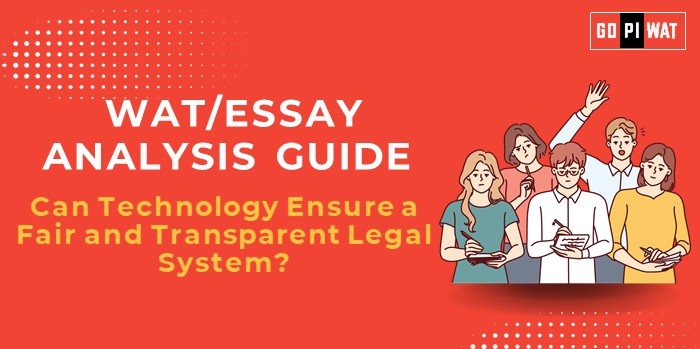📋 WAT Analysis Guide: Can Technology Ensure a Fair and Transparent Legal System?
🌐 Understanding the Topic’s Importance
The integrity of the legal system is fundamental to a democracy. Technology offers the potential to enhance fairness, transparency, and efficiency, aligning with key themes in governance, ethics, and innovation—important considerations for future leaders and policymakers.
⏳ Effective Planning and Writing
- 🕒 Time Allocation (30 minutes):
- 📚 Planning: 5 minutes
- ✍️ Writing: 20 minutes
- 🔍 Review: 5 minutes
💡 Introduction Techniques
- 🔄 Contrast Approach: “While technology accelerates case processing in smart courts worldwide, millions of rural Indians remain unaware of these advancements.”
- ✅ Solution-Based Introduction: “The integration of blockchain and AI offers a groundbreaking solution to judicial inefficiencies, promising transparent and unbiased outcomes.”
📚 Structuring the Essay Body
🏆 Achievements:
- 💻 E-Courts Project: Improved efficiency and accessibility by digitizing case records and enabling online filing.
- 📞 Virtual Hearings: Ensured judicial continuity during the pandemic, processing over 25 million cases online.
⚠️ Challenges:
- 🌐 Digital Divide: Excludes rural and marginalized communities due to limited internet connectivity.
- 🔒 Cybersecurity: Increasing threats to sensitive legal data, as seen in high-profile cyberattacks.
🚀 Future Outlook:
- 🔗 Blockchain: Use for secure, tamper-proof document management.
- 🤖 AI Tools: Develop algorithms for unbiased legal decision-making and case prioritization.
📝 Concluding Effectively
⚖️ Balanced Approach:
“Technology’s potential in the judiciary is immense, yet its success lies in addressing digital inequities and ensuring cybersecurity.”
🌍 Global Comparison Approach:
“India must draw lessons from Estonia and China to create a scalable and inclusive e-judiciary system.”
🔧 Recommendations for Sustainable Progress
- 🌐 Enhance Rural Digital Infrastructure: Expand broadband access to improve participation from underserved regions.
- 📖 AI Ethics Training: Train judicial staff to ensure responsible use of AI tools in decision-making.
- 🔒 Strengthen Cybersecurity: Build robust frameworks to safeguard sensitive legal data and case records.
✍️ Sample Short Essays (100 Words Each)
- ⚖️ Balanced Perspective: “Technology holds transformative power for legal systems, ensuring efficiency and transparency. However, challenges like digital inequity and cybersecurity demand immediate attention. Success hinges on a balanced approach that combines digital tools with inclusivity.”
- ✅ Solution-Oriented: “The adoption of blockchain and AI can revolutionize India’s legal system. By digitizing records and automating processes, we can ensure timely and transparent justice. Bridging digital divides is critical for equitable success.”
- 🌍 Global Comparison: “While Estonia’s digital courts provide a model of efficiency, India’s challenges underscore the need for tailored solutions. Adapting global best practices can enhance our legal framework.”


